| Pages:
1
2
3
4
5 |
aga
Forum Drunkard
    
Posts: 7030
Registered: 25-3-2014
Member Is Offline
|
|
Starting with 3.00g CuSO4 (5H2O ?) dissolved in 40ml DIW
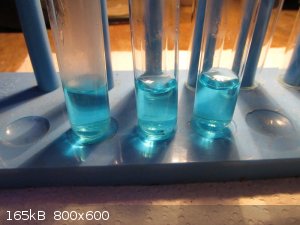
2ml of 33% Ammonia was added.
TACS is destroyed in acidic conditons.
1 ml of conc H2SO4 was added to the Right hand test tube.
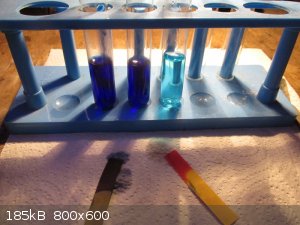
Re-basifying the right-hand sample with more ammonia gave a two-layer system in which the TACS colour re-appeared.
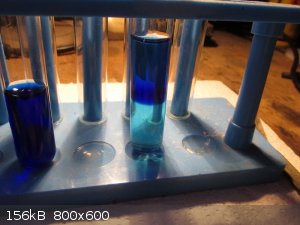
Adding 3% H2O2 caused fizzing/mild foaming with a brown tint to the bubbles.
Brown particulate matter was clearly seen.
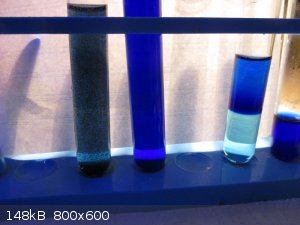
Adding H2O2 to just the CuSO4 solution gave no reaction.
Adding a few grains of NaOH to the left hand H2O2 + CuSO4 solution caused fizzing and a lot of brown particulate
matter to precipitate.
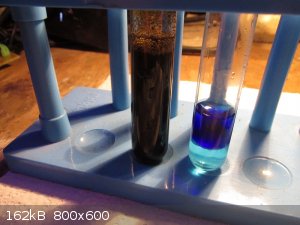
[Edited on 6-11-2015 by aga]
|
|
|
deltaH
Dangerous source of unreferenced speculation
    
Posts: 1663
Registered: 30-9-2013
Location: South Africa
Member Is Offline
Mood: Heavily protonated
|
|
Copper sulfate is dissolved in excess ammonia, results in the formation of a solution of Schweizer's reagent (tetraaaminecopper(II) hydroxide) and
ammonium sulfate.
Now you add hydrogen peroxide. This oxidises some of the ammonia and maybe forms copper(I) oxide which precipitates as the brown stuff, but the latter
is surprising.
NOTE: Please stop speaing about "copper oxide", copper has two oxides, black CuO or cupric oxide or copper(II) oxide and the red-brown cuprous oxide,
Cu2O or copper(I) oxide.
It is possible that the ammonia doesn't get oxidised at all and this can be confirmed by doing the same reaction, but using sodium hydroxide to
precipitate copper(II) hydroxide and then add the peroxide. If it forms the same brown stuff, then the ammonia is simply acting as a base and not
really doing anything else. If not, ammonia is getting oxidised and plays a key role here.
[Edited on 6-11-2015 by deltaH]
|
|
|
aga
Forum Drunkard
    
Posts: 7030
Registered: 25-3-2014
Member Is Offline
|
|
Quote: Originally posted by deltaH  | | It is possible that the ammonia doesn't get oxidised at all and this can be confirmed by doing the same reaction, but using sodium hydroxide to
precipitate copper(II) hydroxide and then add the peroxide. |
OK !
Copper Sulphate solution with some random amount of NaOH added.
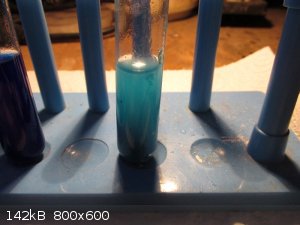
Now add the 3% H2O2
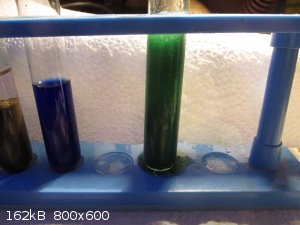
Fizzed like crazy and some foam left the test tube at moderate speed.
It is now a Green solution.
Will leave it overnight to see if it has any precipitate.
@Velzee
Big thanks !
I was being grumpy and jealous - this is great fun !
[Edited on 6-11-2015 by aga]
|
|
|
deltaH
Dangerous source of unreferenced speculation
    
Posts: 1663
Registered: 30-9-2013
Location: South Africa
Member Is Offline
Mood: Heavily protonated
|
|
Very interesting, I didn't expect the copper hydroxide to go green upon addition of the peroxide in the case of the sodium hydroxide addition 
|
|
|
aga
Forum Drunkard
    
Posts: 7030
Registered: 25-3-2014
Member Is Offline
|
|
Seems to me that the Ammonia is just contributing OH<sup>-</sup> to the mix.
Strange.
After NaOH, KOH and Ammonia, i struggle to lay hands on another strong base.
Got plenty of acids, which means i'm acid-biased.
DOH !
|
|
|
MolecularWorld
Hazard to Others
  
Posts: 110
Registered: 30-10-2015
Member Is Offline
Mood: No Mood
|
|
Quote: Originally posted by deltaH  | Copper sulfate is dissolved in excess ammonia, results in the formation of a solution of Schweizer's reagent (tetraaaminecopper(II) hydroxide) and
ammonium sulfate.
|
No, it forms <a href="http://en.wikipedia.org/wiki/Tetraamminecopper(II) sulfate" target="_blank">tetraamminecopper(II) sulfate</a>
<img src="../scipics/_wiki.png" />.
| Quote: |
Now you add hydrogen peroxide. This oxidises some of the ammonia and maybe forms copper(I) oxide which precipitates as the brown stuff, but the latter
is surprising.
|
Yep.
| Quote: |
NOTE: Please stop speaing about "copper oxide", copper has two oxides, black CuO or cupric oxide or copper(II) oxide and the red-brown cuprous oxide,
Cu2O or copper(I) oxide.
|
I was aware of this, but I didn't know which of the oxides was being produced, and since they behave similarly under these conditions, it really
doesn't matter. I will henceforth use the term "an oxide of copper" when referring to a compound of copper and oxygen at an unknown ratio.
| Quote: |
It is possible that the ammonia doesn't get oxidised at all and this can be confirmed by doing the same reaction, but using sodium hydroxide to
precipitate copper(II) hydroxide and then add the peroxide. If it forms the same brown stuff, then the ammonia is simply acting as a base and not
really doing anything else. If not, ammonia is getting oxidised and plays a key role here.
|
There is no hydroxide in tetraamminecopper(II) sulfate. It's not like making Tollens' reagent, at no point in the addition of ammonia to copper
sulfate did a precipitate appear. As such, reacting hydrogen peroxide with copper hydroxide is a completely different and largely unrelated reaction.
Quote: Originally posted by aga  |
Copper Sulphate solution with some random amount of NaOH added.
Now add the 3% H2O2
Fizzed like crazy and some foam left the test tube at moderate speed.
It is now a Green solution. |
That's surprising. The liquid appears to be a much brighter green than any my reactions produced. Gotta get some more peroxide and try it myself!
[Edited on 7-11-2015 by MolecularWorld]
|
|
|
aga
Forum Drunkard
    
Posts: 7030
Registered: 25-3-2014
Member Is Offline
|
|
Doing is believing.
Edit
Or at least verifying ...
[Edited on 6-11-2015 by aga]
|
|
|
MolecularWorld
Hazard to Others
  
Posts: 110
Registered: 30-10-2015
Member Is Offline
Mood: No Mood
|
|
Here's an interesting reference:
| Quote: |
"At 0°C neutral hydrogen peroxide converts an aqueous suspension of cupric hydroxide into the brown, crystalline peroxide."
"The product is always more or less impure. When moist, it decomposes rapidly with evolution of oxygen and formation of cupric oxide, but the
decomposition of the dry substance is slow."
"The compounds obtained by the action of hydrogen peroxide on cupric hydroxide are regarded by Aldridge and Applebey as probably consisting of a
mixture in varying proportions of cupric oxide and hydroxide with a yellow, gelatinous peroxide of the formula CuO2."
|
A mixture of yellow peroxide and blue hydroxide could produce the green coloration. If the above is applicable, I would expect your green liquid to
turn brown.
|
|
|
Velzee
Hazard to Others
  
Posts: 381
Registered: 19-8-2015
Location: New York
Member Is Offline
Mood: Taking it easy
|
|
This is a lot more interesting than I first imagined! xD I want more supplies!
Check out the ScienceMadness Wiki: http://www.sciencemadness.org/smwiki/index.php/Main_Page
"All truth passes through three stages. First, it is ridiculed. Second, it is violently opposed. Third, it is accepted as being self-evident."
—Arthur Schopenhauer
"¡Vivá Cristo Rey!"
—Saint José Sánchez del Río |
|
|
aga
Forum Drunkard
    
Posts: 7030
Registered: 25-3-2014
Member Is Offline
|
|
That's the way it goes - something looks Boring and can turn out to be fascinating !
We shall see if my Finest Green of MostGreenyNess goes Brown.
I'll dump it into a petri dish so it can oxidise faster (would have thought the H2O2 would have done that already ...)
|
|
|
aga
Forum Drunkard
    
Posts: 7030
Registered: 25-3-2014
Member Is Offline
|
|
Well, i was about to dump the Green liquid into a petri dish and saw this ....
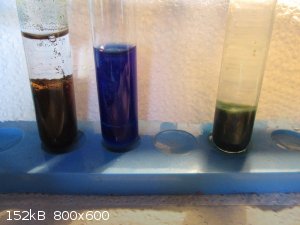
The colours are hard to make out.
There is a dark green layer on top with a blue layer on the bottom.
Here's a close-up in sunlight
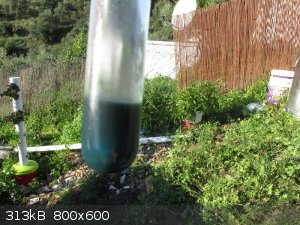
|
|
|
MolecularWorld
Hazard to Others
  
Posts: 110
Registered: 30-10-2015
Member Is Offline
Mood: No Mood
|
|
Quote: Originally posted by aga  | Well, i was about to dump the Green liquid into a petri dish and saw this ....
The colours are hard to make out.
There is a dark green layer on top with a blue layer on the bottom.
Here's a close-up in sunlight
|
If you were using 3% peroxide, there was probably an excess of copper hydroxide, which settled out. Some hydroxide stays in solution/suspension, and,
if there's a "yellow, gelatinous peroxide", as my reference above states, the mixture in suspension would look green.
If the liquid is a mixture of copper hydroxide and copper peroxide, it should decompose on gentle heating to brown/black cupric oxide with the
production of some oxygen. The hydroxide by itself would also decompose, but without producing gasses.
Which reaction produced the brown precipitate and colorless solution in the tube at the left?
|
|
|
aga
Forum Drunkard
    
Posts: 7030
Registered: 25-3-2014
Member Is Offline
|
|
Erm (blush) i cannot remember.
This is a big problem with random 'mixing stuff up'.
Certainly two or more of copper sulphate/ammonia/NaOH/hydrogen peroxide.
I do recall that one went brown the instant the reactants were mixed, with strong fizzing.
[Edited on 7-11-2015 by aga]
|
|
|
MolecularWorld
Hazard to Others
  
Posts: 110
Registered: 30-10-2015
Member Is Offline
Mood: No Mood
|
|
Quote: Originally posted by aga  | Erm (blush) i cannot remember.
This is a big problem with random 'mixing stuff up'.
Certainly two or more of copper sulphate/ammonia/NaOH/hydrogen peroxide.
I do recall that one went brown the instant the reactants were mixed, with strong fizzing. |
Based on your posts above, it's either: TACS + peroxide; or copper sulfate + peroxide + NaOH (in that order). You might be able to differentiate
between the two by adding some hydroxide to the colorless liquid, only the TACS + peroxide mixture would smell of ammonia (assuming the ammonia isn't
completely destroyed by the reaction).
Re-reading your posts, I realized something: the only difference between
Quote: Originally posted by aga  |
Adding H2O2 to just the CuSO4 solution gave no reaction.
Adding a few grains of NaOH to the left hand H2O2 + CuSO4 solution caused fizzing and a lot of brown particulate
matter to precipitate. |
and
Quote: Originally posted by aga  |
Copper Sulphate solution with some random amount of NaOH added.
Now add the 3% H2O2
Fizzed like crazy and some foam left the test tube at moderate speed.
It is now a Green solution. |
...is that, in the first case, any copper peroxide formed would be subject to the localized heating around the dissolving NaOH prills, causing it to
immediately decompose to cupric oxide and oxygen. In the second case, there might not have been enough heat to decompose the copper peroxide, which it
why it persisted to give a "green" liquid (actually a suspension of brown/yellow and blue particles). Again, if the green liquid is a mixture of
suspended of copper peroxide and copper hydroxide, gentle heating should decompose it to cupric oxide and oxygen. This will also happen slowly at room
temperature (though the gas evolution may be too little and too slow to notice). Alternately, due to the ejection of foam, it's possible very little
of the peroxide reacted with the copper hydroxide, but all of the copper peroxide thus formed decomposed, creating a only a small amount of cupric
oxide in suspension with the rest of the copper hydroxide. In which case, the green liquid would decompose on heating, but without evolution of any
gasses.
|
|
|
aga
Forum Drunkard
    
Posts: 7030
Registered: 25-3-2014
Member Is Offline
|
|
@Velzee
This what proper chemists can do without even knowing the precise quantities !
(I mean MolecularWorld, not me.)
OK. MW, will go heat the green/blue stuff and post another photo.
|
|
|
aga
Forum Drunkard
    
Posts: 7030
Registered: 25-3-2014
Member Is Offline
|
|
The Green part is actually looking Blacker than earlier, however it is Night here. Some Blue is still visible at the bottom.
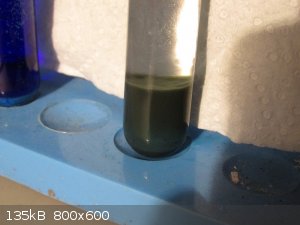
Removing some of the water and shaking gives a very dark green colour, almost black.
Gentle heating for ~1 minute has converted all the Colour to brown/black with no bubbles evolved.
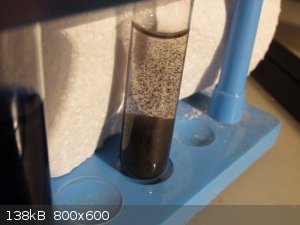
The brown/black precipitate settled very quickly.
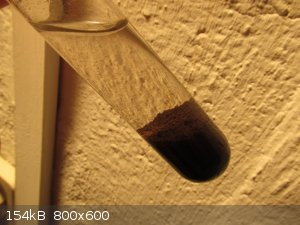
[Edited on 7-11-2015 by aga]
|
|
|
MolecularWorld
Hazard to Others
  
Posts: 110
Registered: 30-10-2015
Member Is Offline
Mood: No Mood
|
|
@aga: I'm far from "proper chemist", but I have read a lot and do enjoy the occasional "random mixing stuff up". 
Based on the all the experimental data presented here by aga, Velzee, and myself, as well as this Wikipedia article that appeared mysteriously a few hours ago, I can say with a high degree of confidence that our reactions of hydrogen
peroxide with tetraamminecopper(II) sulfate solution and copper hydroxide suspension are both producing <a
href="http://en.wikipedia.org/wiki/Copper_peroxide" target="_blank">copper peroxide</a> <img src="../scipics/_wiki.png" />, an unstable
olive-green compound. This decomposes rapidly, to give oxygen gas and mixtures containing varying amounts of brown/black cupric oxide and excess
blue-colored reactants, which look green in combination.
I'm still curious as to what the byproducts of the reaction between tetraamminecopper(II) sulfate solution and hydrogen peroxide are. I'll be doing
some experiments later this week in an attempt to determine the nature of complete reaction.
|
|
|
aga
Forum Drunkard
    
Posts: 7030
Registered: 25-3-2014
Member Is Offline
|
|
Please 'fess up when you're done (report your findings !).
|
|
|
aga
Forum Drunkard
    
Posts: 7030
Registered: 25-3-2014
Member Is Offline
|
|
Quote: Originally posted by MolecularWorld  |
No, it forms <a href="http://en.wikipedia.org/wiki/Tetraamminecopper(II) sulfate" target="_blank">tetraamminecopper(II) sulfate</a>
<img src="../scipics/_wiki.png" />. |
As a very inexperienced amateur chemist, i feel that i must challenge that assertion.
Tetraaminecopper(II) sulphate should really only exist as a Solid.
In solution it's a mix of Ions (tetraaminecopper(II)<sup>2+</sup> and SO4<sup>2-</sup> ?)
It's a bit like saying NaCl in solution is NaCl, wheras in aqueous solution it is Na<sup>+</sup> and Cl<sup>-</sup>
[Edited on 7-11-2015 by aga]
|
|
|
MolecularWorld
Hazard to Others
  
Posts: 110
Registered: 30-10-2015
Member Is Offline
Mood: No Mood
|
|
Remember, that assertion was in response to:
Quote: Originally posted by deltaH  | Copper sulfate is dissolved in excess ammonia, results in the formation of a solution of Schweizer's reagent (tetraaaminecopper(II) hydroxide) and
ammonium sulfate.
|
You're right that there's an equilibrium between a variety of ionic species. But in perfectly stoichiometric tetraamminecopper(II) sulfate, the ratio
of ammonia:copper:sulfate is 4:1:1. If it were instead a mixture of tetraamminecopper(II) hydroxide and ammonium sulfate, the ratio would be
different; eg, for there to be a 1:1 copper:sulfate ratio, there would be 6 ammine/ammonium ions.
[Edited on 7-11-2015 by MolecularWorld]
|
|
|
aga
Forum Drunkard
    
Posts: 7030
Registered: 25-3-2014
Member Is Offline
|
|
Wow ! (at least) 6 species in an ionic soup.
No wonder this was a tricky one to work out.
Unlikely to be in 'correct' stoichiometric amounts either in the OP or my own random mix-ups, so i guess anything could happen, including the ionic
versions of what deltaH said.
pH seems to be a Key part in all of this.
Excellent that your heating suggestion turned out as expected.
|
|
|
JJay
International Hazard
    
Posts: 3440
Registered: 15-10-2015
Member Is Offline
|
|
Woot! I just got a near-quantitative yield using OTC reagents in a synth that had pretty crappy yields in the literature.
|
|
|
MolecularWorld
Hazard to Others
  
Posts: 110
Registered: 30-10-2015
Member Is Offline
Mood: No Mood
|
|
Quote: Originally posted by JJay  | | Woot! I just got a near-quantitative yield using OTC reagents in a synth that had pretty crappy yields in the literature. |
All right, I'll play along. Per the topic of this thread: WTF did you just make?
|
|
|
JJay
International Hazard
    
Posts: 3440
Registered: 15-10-2015
Member Is Offline
|
|
I'm actually trying to figure that out... there seems to be some controversy over what the product of this reaction is... right now I am distilling
some DCM off of an extraction from a reaction with the product to see if I get anything. The reaction did not run as I expected, but it could be that
one of the side products simply didn't decompose as fast as I expected.
EDIT: The synth was too good to be true.... I definitely did not get the product I wanted; I got some isomer in near-quantitative yield. I don't know
what it is, but I don't really care either.
[Edited on 9-11-2015 by JJay]
|
|
|
MolecularWorld
Hazard to Others
  
Posts: 110
Registered: 30-10-2015
Member Is Offline
Mood: No Mood
|
|
Back to tetraamminecopper(II) sulfate and ammonia...
I currently lack the means to determine the exact concentration of my ammonia solution, but the MSDS states it's at least 2%. Based on that, I
prepared a solution of tetraamminecopper(II) sulfate with an excess of ammonia by adding 10g of copper sulfate pentahydrate to 1L of this ammonia
solution. This was diluted again by half for use in the video below.
When 3% hydrogen peroxide is added to this solution, much gas is evolved, and the liquid turns a dingy green. This may be due to the formation of
copper peroxide, or due to suspended particles of cupric oxide in the blue solution.
<iframe sandbox width="280" height="156" src="//www.youtube.com/embed/P_nXcoSV0ks?rel=0" frameborder="0" allowfullscreen></iframe>
The gasses reignite a smoldering splint, though not as rapidly as I would expect from pure oxygen. The volume of gas is too large to be explained
simply from the decomposition of the peroxide. I suspect the gasses produced at this point are a mixture of nitrogen and oxygen, with a greater
concentration of oxygen than air.
More peroxide is added, until rate of gas production drops significantly. This indicates the primary reaction is complete, and the peroxide is simply
being decomposed catalytically by the cupric oxide particles. This leaves a dark brown suspension of extremely fine cupric oxide particles in a
colorless solution. There was not enough gas produced at this point for me to confirm it's identity with a smoldering splint.
The solution was heated gently and allowed to settle, resulting in a brown precipitate and a light blue solution.
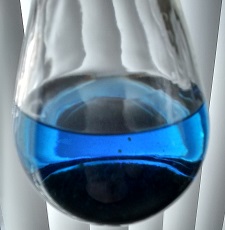
My tests earlier in this thread show that the fine cupric oxide will dissolve slowly in ammonia, and as my tetraamminecopper(II) sulfate had excess
ammonia, this gives the slight blue coloration. With perfectly stoichiometric tetraamminecopper(II) sulfate, I expect a colorless solution. I lack the
means to determine the exact concentration of my ammonia, so I'm unable to prepare a 'pure' tetraamminecopper(II) sulfate solution at this time.
The colorless (slightly blue) solution was decanted. A small aliquot was added to sodium hydroxide: a stronger ammonia odor results, and the solution
is nearly decolorized. This suggests the presence of ammonium, and very little copper in solution. Another aliquot was added to calcium chloride
solution: the solution turns cloudy, and a small amount of white precipitate eventually settles. This suggests the presence of sulfate.
Thus:
On addition of hydrogen peroxide to tetraamminecopper(II) sulfate solution:
- Copper peroxide is formed.
- Some of the ammonia is oxidized to nitrogen (and water)
- The copper peroxide is decomposed by the heat of the oxidizing ammonia, to give cupric oxide and oxygen
- The solution remaining after the cupric oxide precipitates is ammonium sulfate
Overall reaction:
2 [Cu(NH3)4]SO4 + 6 H2O2 → 2 CuO + 2 (NH4)2SO4 + 12
H2O + 2 N2 + O2
I may repeat these tests once I can prepare stoichiometric tetraamminecopper(II) sulfate solution.
[Edited on 13-11-2015 by MolecularWorld]
|
|
|
| Pages:
1
2
3
4
5 |